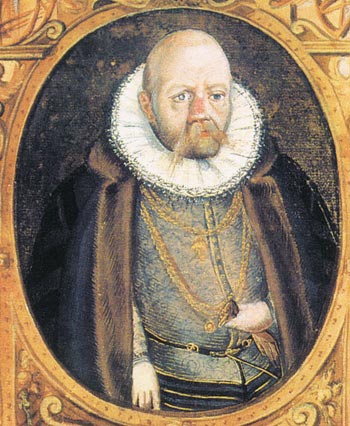The Nobleman and His Housedog: Tycho Brahe and Johannes Kepler – The Strange Partnership that Revolutionised Science
Kitty Ferguson
2002 Review 372pp £15.99/$31.98hb

Kitty Ferguson presents a double biography with a single theme: the founding of modern astronomy. Johannes Kepler is rightly acclaimed as the father of modern astronomy, but he could not have achieved this distinction without Tycho Brahe’s observational data, which are unanimously considered the most accurate and comprehensive in pre-telescopic astronomy.
Science needs imaginative, daring theorists who can soar high in the world of the almost impossible; Kepler belonged to this tribe. Science also needs accurate observational data to keep this search bound to the ground; Tycho’s data did just this. But this merging of theory and experiment was by no means straightforward or easy.
The Nobleman and His Housedog recounts the strange and intricate way in which this unusual collaboration came about. The story begins with Tycho Brahe – the Danish nobleman of the book’s title – who was 25 years older than Kepler. Breaking with the established traditions of his society, which frowned upon any nobleman engaging in a scientific career, Tycho had been interested in astronomical observations since his youth.
It was from his home observatory at Herrevad that he observed the well known nova of 1572, which challenged the Aristotelian doctrine of the immutability of the celestial world. Later he found lavish favour with King Frederick II of Denmark, who went all out to help him set up an extravagant state-of-the-art observatory at Uraniborg and the subterranean observatory of Stjerneborg on the island of Hven.
However, Tycho fell badly out of grace with King Christian IV – Frederick’s successor – and was forced to leave Denmark in disgrace in 1597. Soon Emperor Rudolph II of the Holy Roman Empire welcomed him in Prague and extended generous support to set up an observatory at nearby Benatky. Unfortunately, Tycho’s life and activities at Benatky were cut short by his rather untimely death in 1601, although he left a priceless legacy in the form of the most accurate astronomical observations – the fruit of 38 years of tireless, ingenious labour.
Tycho had been unhappy with the old Ptolemaic system; the new Copernican theory also failed to satisfy him. He in turn proposed a different system, popularly known as the Tychonic system, in which all the planets (except the Earth) went round the Sun, and the Sun orbited round the Earth. This system, he claimed, steered clear of the mathematical absurdity of Ptolemy and the physical absurdity of Copernicus.
Kepler, meanwhile, was following a very different path. Born in Weil der Stadt near Stuttgart in 1571, he could hardly claim any noble lineage. Deeply religious and fired by a powerful desire to become a Lutheran minister, he went to study theology at the University of Tübingen. There he came under the influence of the crypto-Copernican astronomer Michael Möstlin, and became a Copernican himself. Soon he had to interrupt his theological studies to become a mathematics teacher and district mathematician in Graz in present-day Austria.
Kepler first came to the notice of the scholarly world when he published Mysterium Cosmographicum in 1596. The book detailed his “polyhedral theory”, which explained the arrangement of the different planets in terms of the five regular solids. Although a theorist, Kepler longed impatiently to consult Tycho’s data to confirm his theory.
A very strange confluence of circumstances offered Kepler the opportunity to fulfil his desire. Religious persecution and poverty drove Kepler out of Graz. While his polyhedral theory turned out to be a phantasm, its ingenuity and originality revealed a brilliant and highly creative genius in the making. He quickly received a shower of encomiums from many scholars including Tycho, who extended an open and warm-sounding invitation to join him at Benatky.
Rarely can one find two personalities so poles apart as Tycho and Kepler. Flamboyant and extravagant, the Dane wallowed in pomp and luxury, even though his lifestyle meant emptying the royal coffers and squeezing the sweat out of his impoverished Danish tenants. For Kepler, however, the wayward life of his mercenary father, the sporadic, witch-like behaviour of his mother and the chronic poverty of his family had always prevented him from claiming a place in high society.
Tycho was arrogant and merciless towards his opponents – he went after Nicolas Ursus’s blood (even after the latter’s ignominious death) because he believed that Ursus had plagiarized his astronomical system. Kepler, on the other hand, was self-effacing and self-disparaging – he referred to himself as a “housedog” and a “worm”. The Dane was a genius at observations and devising observational instruments. The German – with his highly creative mind and imaginative insights – was a grand master at theorizing. Tycho was self-centred and overprotective of his observational data, persistently refusing to share his scientific treasure with Kepler. Kepler for the most part was generous and ready to share his knowledge with other scholars.
No wonder the so-called collaboration was strange and stormy. During the first months of their time together, the pair pouted at each other, argued constantly, quarrelled frequently and finally – in a fit of anger and disappointment – Kepler walked out. But Tycho had the good sense and magnanimity to relent, and finally the differences were patched up. Kepler was given the formidable task of studying the erratic movement of Mars, which neither Tycho nor any of even his best assistants could tackle. This was providential since the path of Mars deviated most from the circular path, and Tycho’s accurate data were able to render this deviation perceptible.
Tycho’s untimely death in 1601 also turned out to be a blessing in disguise for Kepler since this led him to become the prestigious Imperial Mathematician in Prague, and gave him relatively free access to Tycho’s data. Although he struggled with the Martian orbit for several years, he was finally rewarded with the discovery of the first two laws of planetary motion that now bear his name. He discovered the third law several years later while working on musical harmony applied to the motion of planets.
Ferguson succeeds in bringing out the complex lives of these two giants and the enormity of the challenges that lay before them. She also beautifully locates them in the social, religious and political milieu thereby affirming that scientists and the science that they help to create cannot be divorced from the people they are and the world they live in. The book also provides a good feeling for the Europe of the period, especially of Denmark. The style is lucid and smooth, avoiding all unnecessary technical complexities. Indeed, the entire text reads almost like a historical novel.
However, the sections dealing with Kepler’s long and arduous struggle with Mars are somewhat weak. In her legitimate concern for simplification, Ferguson falls into the trap of all simplifiers: underplaying the role of non-empirical factors in Kepler’s discovery. The crucial role that philosophical and religious principles played cannot be overlooked, particularly the immense struggle Kepler had to undergo to extricate himself from astronomers’ millennia-long attachment to the circular orbit.
Still, the author has made a laudable contribution in casting Tycho in a far better light than others have achieved. Particularly touching is her description of how he broke with tradition to marry a commoner – Kirsten Jørgensdatter – at considerable personal cost all through his life.
Some readers, however, may feel uneasy with the metaphorical reference to Kepler as Tycho’s “housedog”. This self-description is quoted at least three times, and referred to many more. A man with a poor self-image, Kepler was embarrassingly self-effacing. Psychologists tell us that statements from such people about themselves should not be given too much weight. In any case, if Kepler was the “housedog”, this was the rarest case in which the housedog outlived and outsmarted his master.
These comments aside, Ferguson’s work renders valuable and timely service to the Kepler–Tycho scholarship. Non-specialists will learn much about the world of modern science in its infancy. Specialists, meanwhile, will find its many details and insights stimulating for further study and reflection.




